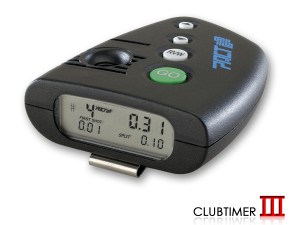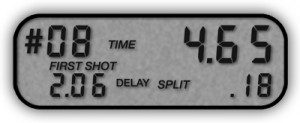Widgetized Section
Go to Admin » Appearance » Widgets » and move Gabfire Widget: Social into that MastheadOverlay zone
Team Erhardt Project: Blazing Saddles Here I Come
This is the latest installment in the Team Erhardt Project series which appears on The Shooting Wire.
Look up slow in the dictionary and you’ll find a reference to my draw.
It’s god-awful.
But what could I expect when I did zero prep before shooting my first Steel Challenge. I don’t think I even had my holster and rig that year until it arrived direct to the hotel in Valencia, California from the maker.
That gives you an idea of how much time I put into my draw. If not, then my 223rd place time of 203.56 seconds does.
I know the mechanics of the draw but I never, ever practiced. Besides, how hard can it be to do it fast, right?
One or two summers later I shot a local New Hampshire match. As I pulled into the lot I saw Dave Sevigny, who had moved from New England down to Georgia to work and shoot for Glock.
After my shocked ‘what are you doing here?’ greeting, Dave explained he was in the area for an ice hockey power skating clinic and decided to shoot the match.
A buddy and I followed Dave around before squadding with him when he shot his second gun.
Watching, and shooting with, a shooter at Dave’s level quickly puts into perspective how slow your draw is – and all the other crap you’re doing wrong like grip, transitions and missing a lot.
While I secretly thought I was Blazing Saddles fast, I was really Mongo slow.
Of course Dave’s speed comes from a certain amount of natural athleticism, that’s obvious, but more from what I am sure has been countless hours practicing his draw. The kind of practice that my crippling disease, chronic laziness, often prevents me from doing.
Unfortunately there’s no escaping the fact that I have to improve my draw. Which means there’s no escaping the fact I have to practice.
What I’ve learned over the last two months is that repetition really does improve your mechanics. My last competition showed me that as I felt much more comfortable, and smoother, reacting to the buzzer and coming out of the holster.
Of course it ain’t fast, but it is, at least, more confident. From there I can push for speed.
However, in order to push the speed I’d need one little piece of equipment that I had as yet failed to acquire – a timer.
I knew I needed a timer to train with. The whole ‘if you can’t measure it, you can’t manage it’ thing isn’t new to me, I was just, well, procrastinating.
The pressure to get a timer got so bad I had random people on Facebook telling me I needed one because it improved their speed, so it’s got to help you, dummy… that’s kinda what they said if you read between the lines.
They were right of course.
On the advice of Smith & Wesson’s Tom Yost, I called Ronin Colman at PACT about getting a Club Timer III.
Either out of kindness, generosity, admiration for my noble effort, or just because he wants a front row seat to the train wreck that could be my 2011 Steel Challenge performance (I know, I know… think positive), Ronin boxed up a PACT Club Timer III while I was still on the phone.
Two days later I found a UPS box on my doorstep, and one less excuse not to practice.
After a quick, and surprisingly easy, read of the instructions I had the timer running and a par time set. It was a crazy fast 1.50 seconds.
For me this is a good starting point. I have been tracking at matches my time to first shot since May. My average stage draw ranges from 1.86 (Pendulum) down to 1.31 (Smoke & Hope).
My worst single draw was 2.24 seconds on 5 To Go and my fastest was 1.16 on Smoke & Hope, of course.
Now to put this into ugly perspective, those are times from the sound of the buzzer to my first shot. By comparison, Max Michel has run Smoke & Hope – all five targets – in a time of 1.69 seconds.
My worst recorded Smoke & Hope first shot was in 1.82 seconds. By that time Max has cleared his gun and reholstered, and I still have four targets to go…assuming I hit the first one.
Clearly a 1.5 second par time works as a starting point for me because I know I can do it and still process whether or not my grip is solid and that my sight picture is good.
Working with the timer I quickly realized that 1.5 seconds really is a lot of time. Before I turned up the speed I practiced breaking the trigger on a good sight picture on the first target and transitioning to a second target before the second buzzer.
What do you know? That worked.
Feeling confident at 1.50 seconds I began to decrease the time starting with 1.40 seconds. Then down to 1.35 and 1.30.
At each stop on the decreasing par time scale I focused on a solid grip, a hard look at that front sight and a controlled dryfire shot I could call a hit – on a 3 inch target at 15 feet.
I even flirted with 1.20 seconds last night and was getting the shot off in time. Progressing at this rate I figure I’ll pass Sevigny to challenge Michel and K.C. Eusebio for fastest draw.
So what did I learn with the timer? Well, I hate dryfiring, and you’re an idiot if you don’t get one too.
Trust me, I speak from experience.
– Paul Erhardt
Follow the Team Erhardt Project on Twitter at @TheShootingWire, use hashtag #TeamErhardt.





 MidwayUSA
MidwayUSA Ruger Firearms
Ruger Firearms SCCY Firearms
SCCY Firearms Streamlight
Streamlight Action Targets
Action Targets Gunsite Academy
Gunsite Academy
You must be logged in to post a comment Login